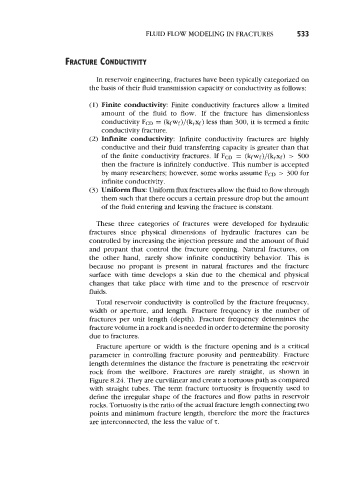Page 566 - Petrophysics
P. 566
FLUID FLOW MODELING IN FRACTURES 533
FRACTURE CONDUCTIVITY
In reservoir engineering, fractures have been typically categorized on
the basis of their fluid transmission capacity or conductivity as follows:
(1) Finite conductivity: Finite conductivity fractures allow a limited
amount of the fluid to flow. If the fracture has dimensionless
conductivity FCD = (kfwf)/(k,xf) less than 300, it is termed a finite
conductivity fracture.
(2) Infinite conductivity: Infinite conductivity fractures are highly
conductive and their fluid transferring capacity is greater than that
of the finite conductivity fractures. If FCD = (kfwf)/(k,xf) > 500
then the fracture is infinitely conductive. This number is accepted
by many researchers; however, some works assume FCD > 300 for
infinite conductivity.
(3) Uniform flux: Uniform flux fractures allow the fluid to flow through
them such that there occurs a certain pressure drop but the amount
of the fluid entering and leaving the fracture is constant.
These three categories of fractures were developed for hydraulic
fractures since physical dimensions of hydraulic fractures can be
controlled by increasing the injection pressure and the amount of fluid
and propant that control the fracture opening. Natural fractures, on
the other hand, rarely show infinite conductivity behavior. This is
because no propant is present in natural fractures and the fracture
surface with time develops a skin due to the chemical and physical
changes that take place with time and to the presence of reservoir
fluids.
Total reservoir conductivity is controlled by the fracture frequency,
width or aperture, and length. Fracture frequency is the number of
fractures per unit length (depth). Fracture frequency determines the
fracture volume in a rock and is needed in order to determine the porosity
due to fractures.
Fracture aperture or width is the fracture opening and is a critical
parameter in controlling fracture porosity and permeability. Fracture
length determines the distance the fracture is penetrating the reservoir
rock from the wellbore. Fractures are rarely straight, as shown in
Figure 8.24. They are curvilinear and create a tortuous path as compared
with straight tubes. The term fracture tortuosity is frequently used to
define the irregular shape of the fractures and flow paths in reservoir
rocks. Tortuosity is the ratio of the actual fracture length connecting two
points and minimum fracture length, therefore the more the fractures
are interconnected, the less the value of 2.

